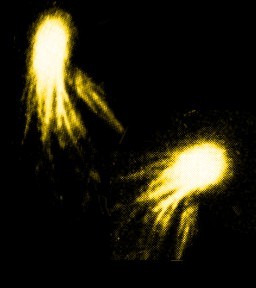
By Amarendra Swarup
Newscientist.com
6-7-06
Ball lightning – the mysterious slow-moving spheres of light occasionally seen during thunderstorms – has been created in the lab.Newscientist.com
6-7-06
Researchers at the Max Planck Institute for Plasma Physics and the Humboldt University, both in Berlin, have used underwater electrical discharges to generate luminous plasma clouds resembling ball lightning that last for nearly half a second and are up to 20 centimetres across.
They hope that these artificial entities will help them understand the bizarre phenomenon and perhaps even provide insights into the hot plasmas needed for fusion power plants.
You can watch a super-slow-motion video of the ball lightning here (3.7MB AVI).
Ball lightning has puzzled scientists for centuries. Though little reliable data exist, there have been many anecdotal sightings, with people as diverse and famous as Charlemagne, Henry II and the physicist Niels Bohr all claiming to have seen it.
In 1753, Russian scientist Georg Richmann may even have been killed by it while trying to trap lightning, becoming the first recorded person to die while conducting electrical experiments.
Glowing ball
Most accounts describe a hovering, glowing, ball-like object up to 40 centimetres across, ranging in colour from red to yellow to blue and lasting for several seconds or in rare cases even minutes. Many scientists believe ball lightning is a ball of plasma formed when lightning strikes the ground, but the exact mechanism is unclear despite the many theories proposed.
Earlier in 2006, Israeli scientists created plasma balls by using microwaves to vaporise various materials, but Gerd Fussmann and his colleagues used a different approach that they believe comes closer to the natural phenomenon. “It is likely that lightning flashes and water interact to produce ball lightning,” says Fussmann. “We therefore use a short, high-voltage discharge of 5000 volts to vaporise some of the water in a glass tank and create the plasma ball.”
The tank contains two electrodes, one of which is insulated from the surrounding water by a clay tube. The high voltage causes enormous currents of up to 60 amps – over 200 times those needed to cause death – to flow through the water for a fraction of a second. These enter the clay tube, causing the water there to evaporate and a luminous plasma ball - consisting of ionised water molecules - to rise from the surface.
Long-lived
“The balls survive up to 0.3 seconds after the current is switched off – far longer than normal plasmas, which decay away far more quickly,” says Fussmann. For example, the plasmas used in laboratories and nuclear fusion plants decay within milliseconds of the power being switched off.
Despite the bright glow, the balls also appear to be rather cold, much like neon lights. A sheet of paper placed above them is lifted but does not catch fire.
Fussmann is now examining the light emission spectrum of the balls and plans to test whether their size and lifespan is affected by the voltage size. Learning to control plasma in this way might help in the development of better fusion power plants that generate energy by burning massive plasma balls of hydrogen.
To determine exactly what happens when ball lightning occurs naturally, he hopes to compare the properties of his ball lightning with existing theories about where it comes from.
Dusty plasma
One theory is that the persistent glow is produced by dusty plasma, generated by lightning striking the ground, melting it locally and ejecting fine nano-particles of sand into the atmosphere.
John Abrahamson at the University of Canterbury, New Zealand, who proposed this theory, says that the luminosity produced by Fussmann’s lightning could be the result of clay and metal from the electrode being vaporised, leading to a glowing dusty suspension of fine particles.
Fussmann disagrees. “Preliminary results indicate the cloud contains mostly ionised hydrogen and oxygen,” he says. “While there are traces of copper, these are negligible.”
Other physicists are cautious. “The results seem a step forward though not a breakthrough yet,” says Eli Jerby at Tel Aviv University, Israel, who produced the microwave-generated ball lightning earlier this year. “However, they need to be reviewed by other scientists to evaluate correctly their originality and importance.”
More . . .
See Also:E.T hunters swarm to the Northwest

No comments :
Post a Comment
Dear Contributor,
Your comments are greatly appreciated, and coveted; however, blatant mis-use of this site's bandwidth will not be tolerated (e.g., SPAM etc).
Additionally, healthy debate is invited; however, ad hominem and or vitriolic attacks will not be published, nor will "anonymous" criticisms. Please keep your arguments "to the issues" and present them with civility and proper decorum. -FW